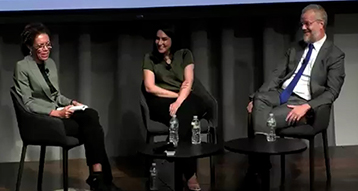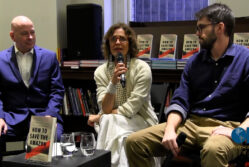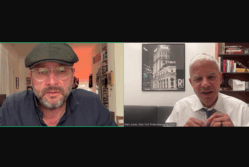Archive Event Highlight

‘How I Did It’: New York Times Team Shares Insight About Investigations into Airstrike Casualties
by Chad Bouchard
OPC Vice President Azmat Khan spent five years gathering string for an award-winning investigation that exposed the full scale of civilian tolls from U.S.-led airstrikes in Iraq, Syria and Afghanistan. But she told guests at Columbia University on Sept. 13 that conviction, strategy and a well-researched pitch would help students find publishers for any good story idea.
The OPC, in collaboration with the Li Center, hosted a discussion about the process behind “The Civilian Casualty Files,” a deep dive into how the military withheld the true civilian death toll and wielded a system lacking in transparency and accountability. Khan was joined by Luke Mitchell, her New York Times Magazine editor, and OPC Governor Ginger Thompson, who served as moderator. Thompson is the chief of correspondents at ProPublica and the winner of multiple journalism awards for her reporting from Latin America and from the U.S.-Mexico border, moderated the discussion.
The discussion was part of an OPC series, called ‘How I Did It,’ which convenes freelance journalists and their editors or producers to break down a major feat of reporting.
Khan’s work has won OPC awards for 2021 and 2017, the Pulitzer Prize in International Reporting, two National Magazine Awards, a Polk Award and the Hillman Prize for Magazine Journalism, among others.
She opened the program with a slide show and presentation about the start of her reporting in early 2016, when she began to interrogate the U.S. military’s claims that its anti-ISIS air campaign had killed 25,000 ISIS fighters but only 21 civilians.
Khan tracked down and visited bombing sites, corroborating the accounts of those on the ground with video and photographs of damage that had been released publicly. One airstrike video released by the U.S. military claimed the target was a car bomb factory. But the location turned out to be two civilian homes where four family members were killed by U.S. strikes following shoddy and misinterpreted ground intelligence.
She met a survivor of the attack, a Mosul resident named Basim Razzo, and “was incredibly moved,” she said. “And I wanted to know how often this happened, so I sought to do a sample.” She struck out to do a door-to-door ground investigation in the town of Qayyarah in Ninewa province as a test case.
After visiting the first ten airstrike sites, she found that half had resulted in civilian casualties. “That was stunning to me, if you compare that to the numbers that I cited earlier.”
In an 18-month investigation, she worked with her colleague, Anand Gopal, to cross-reference satellite imagery with stories on the ground, building a database of press releases and other data. This work resulted in the New York Times Magazine piece “Uncounted,” which was published in 2016 and won the OPC 2017 Ed Cunningham Award.
The coalition’s data indicated 1 in 157 airstrikes in Iraq resulted in a civilian death, but on the ground they found that a civilian was killed in 1 in 5 airstrikes, a rate 31 times higher than officially reported. They found that in about half of the cases, the casualties appeared to be the result of poor or outdated intelligence, not people who happened to be close to a target, which is how prevailing narratives often frame airstrike casualties.
After the story was published, she built on the process she had used in “Uncounted” to file requests under the Freedom of Information Act (FOIA) for thousands of civilian casualty assessments across a much broader territory in Iraq, Afghanistan and Syria. That story took five years of reporting and became “The Civilian Casualty Files.”
Mitchell and Khan discussed the pitch process and early work on “Uncounted” and the “Civilian Casualty Files.” Initially, Khan pitched the story to several media outlets that rejected the idea, often because they did not have the resources to support reporting in a conflict zone. But Khan said she believed so strongly in the story that she cashed out a small retirement fund and survived on grants and other sources while she continued to report. By the time she was ready to pitch to The New York Times Magazine, she was able to include a year of ground reporting and data. She’d even included a budget estimate, strong details for a narrative lead, and information about her conflict training.
Mitchell said each journalism organization has its own idiosyncratic pitch process, and he described the Times’ system as “cumbersome, time-consuming and confusing.” He recommended getting familiar with the process each media organization has before pitching. “The pitch is really a script for an editor to defend the pitch in a meeting,” at the Times, he said.
Khan said strategic timing was key to the success of her pitch. She said there was not a lot of interest in stories about civilian casualties when she first started shopping the “Uncounted” story around in 2016 and early 2017, because U.S. media were so focused on the presidential election. But that changed after a U.S. airstrike in March 2017 in the al Jadidah District of Mosul killed more than 100 civilians, marking the highest admitted number of civilian deaths from a single incident in the war against ISIS.
Thompson asked Khan about her approach to sources suffering from grief and trauma. Khan said she gave a lot of context to interviewees and was transparent about what she was reporting, and how she obtained records about airstrikes.
“I’d tell [the Iraqi interviewees] what I intended to do with this, I’d tell them ‘you don’t have to answer my questions. If I ask anything that is hurtful or harmful, please know I don’t intend to. Forgive me. You can totally just say “no, I don’t want to answer that.”’”
She also warned parents when graphic images and sensitive information would be shared during the interview so children could be sent out of the room ahead of time.
After preparing for the interview, she would then ask “where does this story start for you?”
“You want to treat [interviewees] with dignity, like they are experts in the towns they live in, that their stories are valuable.”
She spent time establishing basic facts about their lives before delving into trauma of airstrikes. After asking about the “worst day of their lives,” she would then transition to something more uplifting and positive, such as how they are recovering, their faith and their children. In some cases she would spend weeks meeting with a source before they were ready to fully delve into their trauma.
“I think that’s another exceptional part of this story and these kinds of stories,” Thompson added. “The reporters have the benefit of time to build relationships with sources, put their sources at ease, and give their sources some control over the story.”
At the end of the program Thompson asked Khan for parting thoughts.
“I hope you don’t feel intimidated by this,” Khan said, prompting laughter from the crowd. She said she could have done the project with a smaller sample of airstrikes or by focusing on a limited area and still made an impact.
“If you are thinking of a dream story, it really helps to believe in it a lot. This was something I really felt strongly about so I was able to keep working on it. So if there’s something you care about, work on it a little bit here and there, plant seeds that would allow you to make that reporting trip that maybe the institution you’re at is not going to fund, or apply for grants,” she said. “It didn’t happen overnight. It unfolded over a long period of time. I think even from small bits of this, there are things that you can replicate, and can certainly do.”
Khan has a website of resources that she posts for her students and others looking for advice. It includes a condensed version of her syllabus on conflict reporting, a walkthrough of an pitch for an investigative story, a FOIA guide, and other resources for freelancers. Explore Khan’s resource page here.
Click the window below to watch a playlist of video clips on the OPC’s YouTube Channel, including an uncut recording of the whole program.




